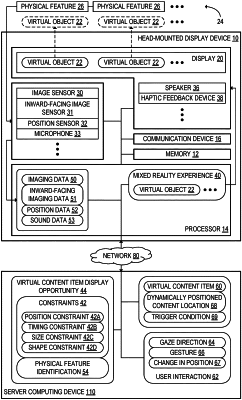| CPC G06T 19/006 (2013.01) [G02B 27/0172 (2013.01); G06F 3/013 (2013.01); G06F 3/017 (2013.01); G06Q 30/0277 (2013.01); G02B 27/017 (2013.01); G02B 27/0179 (2013.01); G02B 2027/014 (2013.01); G02B 2027/0138 (2013.01); G06F 3/012 (2013.01); G06F 3/0482 (2013.01); G06F 3/04845 (2013.01); G06T 19/20 (2013.01); G06V 20/10 (2022.01); H04L 67/01 (2022.05)] | 13 Claims |

|
1. A head-mounted display device, comprising:
an at least partially see-through display;
one or more input devices including:
one or more image sensors configured to collect imaging data of a physical environment; and
an inward-facing image sensor configured to collect inward-facing imaging data of a user;
one or more communication devices; and
a processor configured to:
output for display on the display a mixed reality experience including one or more virtual objects superimposed upon the physical environment;
transmit the imaging data to a server computing device via the one or more communication devices;
receive, from the server computing device, an identification of a virtual content item display opportunity, wherein the identification of the virtual content item display opportunity includes a determination that the mixed reality experience and one or more physical features identified from the imaging data satisfy spatial and temporal constraints;
transmit a request for a virtual content item to the server computing device based on the identification of the virtual content item display opportunity, wherein the request includes a dynamically positioned content item location in the physical environment indicated by the virtual content item display opportunity;
in response to transmitting the request, receive a response from the server computing device, the response including the virtual content item; and
output the virtual content item for display on the display at the selected dynamically positioned content item location;
determine, based at least in part on the inward-facing imaging data, that the user is gazing at the virtual content item and that the virtual content item is occluded by a physical object or a virtual object; and
transmit an indication of a user interaction to the server computing device via the one or more communication devices, wherein:
the user interaction includes gazing at the virtual content item; and
the user interaction further indicates that the virtual content item is occluded.
|